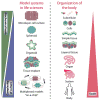Engineering Stem Cell Organoids
- PMID: 26748754
- PMCID: PMC4728053
- DOI: 10.1016/j.stem.2015.12.005
Engineering Stem Cell Organoids
Abstract
Organoid systems leverage the self-organizing properties of stem cells to create diverse multi-cellular tissue proxies. Most organoid models only represent single or partial components of a tissue, and it is often difficult to control the cell type, organization, and cell-cell/cell-matrix interactions within these systems. Herein, we discuss basic approaches to generate stem cell-based organoids, their advantages and limitations, and how bioengineering strategies can be used to steer the cell composition and their 3D organization within organoids to further enhance their utility in research and therapies.
Copyright © 2016 Elsevier Inc. All rights reserved.
Figures





References
-
- Atala A, Yoo JJ. Essentials of 3D Biofabrication and Translation. Elsevier Science; 2015.
-
- Barker N, van Es JH, Kuipers J, Kujala P, van den Born M, Cozijnsen M, Haegebarth A, Korving J, Begthel H, Peters PJ, Clevers H. Identification of stem cells in small intestine and colon by marker gene Lgr5. Nature. 2007;449:1003–1007. - PubMed
-
- Barker N, Huch M, Kujala P, van de Wetering M, Snippert HJ, van Es JH, Sato T, Stange DE, Begthel H, van den Born M, et al. Lgr5(+ve) stem cells drive self-renewal in the stomach and build long-lived gastric units in vitro. Cell Stem Cell. 2010;6:25–36. - PubMed
-
- Bhatia SN, Ingber DE. Microfluidic organs-on-chips. Nat Biotechnol. 2014;32:760–772. - PubMed
Publication types
MeSH terms
Substances
Grants and funding
LinkOut - more resources
Full Text Sources
Other Literature Sources
Medical

